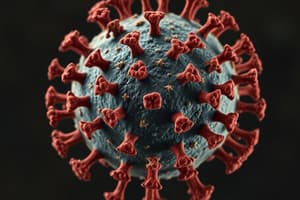Podcast
Questions and Answers
What is the process of developing viral envelopes at the cell membrane called?
What is the process of developing viral envelopes at the cell membrane called?
- Assembly
- Replication
- Budding (correct)
- Fusion
What is the composition of viral envelopes similar to?
What is the composition of viral envelopes similar to?
- Endoplasmic reticulum membrane
- Mitochondrial membrane
- Cellular membrane (correct)
- Nuclear membrane
What is wrapped in a membrane into which viral glycoproteins have been inserted?
What is wrapped in a membrane into which viral glycoproteins have been inserted?
- Nucleocapsid (correct)
- Viral capsid
- Viral RNA
- Viral polymerase
What do some nucleocapsids interact directly with during budding?
What do some nucleocapsids interact directly with during budding?
What do some viruses use to interact with both viral spikes and nucleocapsids during budding?
What do some viruses use to interact with both viral spikes and nucleocapsids during budding?
What does the lipid content of the lipid bilayer reflect?
What does the lipid content of the lipid bilayer reflect?
What is inserted into the lipid membrane to form the viral envelope?
What is inserted into the lipid membrane to form the viral envelope?
What can be used, aside from lipid analyses, to determine where a virus budded from?
What can be used, aside from lipid analyses, to determine where a virus budded from?
What is the nature of viral envelopes in terms of symmetry?
What is the nature of viral envelopes in terms of symmetry?
Where can the process of budding occur?
Where can the process of budding occur?
How are virus species grouped into genera?
How are virus species grouped into genera?
What is a characteristic of most '-' RNA genomes with less than 10kb?
What is a characteristic of most '-' RNA genomes with less than 10kb?
What is a unique mechanism of transcription for dsRNA viruses?
What is a unique mechanism of transcription for dsRNA viruses?
What distinguishes satellite nucleic acids from satellite viruses?
What distinguishes satellite nucleic acids from satellite viruses?
How are plant viruses typically named?
How are plant viruses typically named?
What characteristic distinguishes viruses with dsDNA genomes?
What characteristic distinguishes viruses with dsDNA genomes?
What is the function of reverse transcriptase (RT) in certain viruses?
What is the function of reverse transcriptase (RT) in certain viruses?
What is a characteristic of satellite viruses?
What is a characteristic of satellite viruses?
What distinguishes viroids from other viruses?
What distinguishes viroids from other viruses?
How are bacteriophages typically named?
How are bacteriophages typically named?
What is the function of glycosylation of viral surfaces?
What is the function of glycosylation of viral surfaces?
What do packaging signals on viral genomes interact with to direct the specificity of genome incorporation into virions?
What do packaging signals on viral genomes interact with to direct the specificity of genome incorporation into virions?
What drives the formation of viral envelopes by budding?
What drives the formation of viral envelopes by budding?
What can trigger the release of virion genomes?
What can trigger the release of virion genomes?
How are viruses classified based on molecular architecture and genetic relatedness?
How are viruses classified based on molecular architecture and genetic relatedness?
What is the role of hemagglutinin (HA) from influenza virus?
What is the role of hemagglutinin (HA) from influenza virus?
What do integral membrane proteins Type I and Type II have different of?
What do integral membrane proteins Type I and Type II have different of?
What is the role of core proteins associated with the viral genome inside the capsid?
What is the role of core proteins associated with the viral genome inside the capsid?
What drives budding of virions involving membrane curvature and localized protein aggregates?
What drives budding of virions involving membrane curvature and localized protein aggregates?
What triggers the dissociation of virions?
What triggers the dissociation of virions?
Flashcards are hidden until you start studying
Study Notes
Viral Envelope Glycoproteins and Capsid Assembly
- Envelope glycoproteins have large glycosylated ectodomains, hydrophobic transmembrane anchor domains, and short internal tails, synthesized in the ER and inserted into the plasma membrane via standard export pathways.
- There are two types of integral membrane proteins, Type I and Type II, each with different orientations and signal sequences for membrane insertion.
- Hemagglutinin (HA) from influenza virus has an ectodomain for cell receptor binding, a transmembrane anchor domain, and a cytoplasmic tail.
- Glycosylation of viral surfaces prevents dehydration and reduces protein-protein interactions to prevent viral aggregation.
- Capsid assembly varies based on size, shape, and genomic composition and may involve scaffolding proteins and concatemer formation to fill the genome.
- Packaging signals on viral genomes interact with capsid proteins to direct the specificity of genome incorporation into virions.
- Core proteins associated with the viral genome inside the capsid neutralize negative charges on DNA and condense the viral DNA for optimal packaging, resembling chromatin.
- Interactions between viral proteins drive the formation of viral envelopes by budding, involving membrane curvature and localized protein aggregates.
- Budding can be driven by interactions between envelope glycoproteins, matrix proteins, or nucleocapsids, and may involve different mechanisms depending on the virus type.
- Virions can release their genomes through proteolytic cleavage of capsid proteins, unspooling of the genome, or interaction with cytoplasmic components.
- Virions are energetically metastable and can easily dissociate with the right trigger, such as binding to a receptor or protein on the cell surface or in the cytoplasm.
- Virus classification is based on molecular architecture, genetic relatedness, and host organism, with criteria including nucleic acid genome type, strandedness, topology, capsid symmetry, and presence or absence of an envelope. Comparing genomic and amino acid sequences helps determine genetic relatedness.
Studying That Suits You
Use AI to generate personalized quizzes and flashcards to suit your learning preferences.




